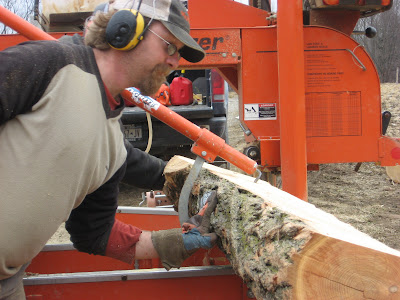Every year we add an arsenal of new equipment to make the hard jobs easier, the heavy jobs lighter and the inefficient jobs more efficient.
Here you can see our new electronic leaf. This little apparatus helps insure that we can sucessfully propagate herbs and plants for our bedding plant business.
When this leaf dries off it lifts up and turns on these misters.
The misters are different from the sprinklers that we have in both greenhouses. They have a very fine spray intended to keep the leaves moist, rather than soaking the soil. Below you can see the cuttings that we have taken. These cuttings are the vegetative (non-woody)tip of the plant that is stripped of it's lower leaves and planted into soil. Many greenhouses operations use a rooting hormone, but we have not found such a thing that is certified organic (though I have heard that a willow bark tea has small amounts of the hormone necessary). The cuttings are planted into 128 cell trays (128 plants per tray) and the trays are placed on the heated floor of our greenhouse. The floor is at a consistent 72 degrees. We have had great sucess with this new system....much better than the 10%-50% sucess rates in years past using a humid germination chamber.

We have improved our radiant floor heating with the oil fired boiler pictured below. Oil heats more efficiently than the older propane system we had last year, and we hope to see a reduction in fuel usage this year.
The water is heated to about 180 degrees before it is pumped out into the tubing which runs every two inches throughout the entire greenhouse. As the water heats the root zone of the plants that are growing on the floor, it cools off, and is pumped back into the boiler to be reheated.
This little contraption below is our much anticipated heat exchanger that warms the water coming out of the watering hose to a lovely 70 degrees. The plants no longer have to endure 50 degree water chilling them to their roots. The warm water just makes them that much happier!!!!
Here is our new offset Kubota cultivating tractor. Now with three tractors that fit into our narrow vegetable field system, we can cultivate, seed, and transplant all at the same time. We have a 1950's era Cub cultivating tractor which only cultivates, we also have a John Deere that seeds, transplants, and cultivates. Alot of time on the farm is spent changing equipment on the tractors. With only one tractor that seeds and cultivates, we were always one break down away from being without an important tool. With a second high clearance cultivating tractor that has a three point hitch we can spread out these important tasks and do them simultaniously.
Below is the new/used 14' disc harrow. This implement helps in the tillage process by cutting and leveling the rough plowed ground, and brings us one step closer to a smooth planting surface.
Above and below you can see our new box scraper. Hooked up to the three point hitch of our tractor, this heavy duty two-way steel blade with cutting teeth allows us to do basic road maintenance and barn yard clean up. We have declared war on the potholes that destroy our trucks and tractors on a daily basis.
So there you have it...a sampling of the equipment that will be hard at work here in 2010!



























